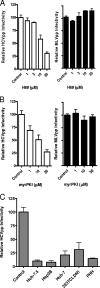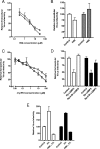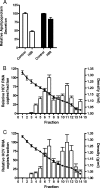Protein kinase A-dependent step(s) in hepatitis C virus entry and infectivity
- PMID: 18579596
- PMCID: PMC2519651
- DOI: 10.1128/JVI.00592-08
Protein kinase A-dependent step(s) in hepatitis C virus entry and infectivity
Abstract
Viruses exploit signaling pathways to their advantage during multiple stages of their life cycle. We demonstrate a role for protein kinase A (PKA) in the hepatitis C virus (HCV) life cycle. The inhibition of PKA with H89, cyclic AMP (cAMP) antagonists, or the protein kinase inhibitor peptide reduced HCV entry into Huh-7.5 hepatoma cells. Bioluminescence resonance energy transfer methodology allowed us to investigate the PKA isoform specificity of the cAMP antagonists in Huh-7.5 cells, suggesting a role for PKA type II in HCV internalization. Since viral entry is dependent on the host cell expression of CD81, scavenger receptor BI, and claudin-1 (CLDN1), we studied the role of PKA in regulating viral receptor localization by confocal imaging and fluorescence resonance energy transfer (FRET) analysis. Inhibiting PKA activity in Huh-7.5 cells induced a reorganization of CLDN1 from the plasma membrane to an intracellular vesicular location(s) and disrupted FRET between CLDN1 and CD81, demonstrating the importance of CLDN1 expression at the plasma membrane for viral receptor activity. Inhibiting PKA activity in Huh-7.5 cells reduced the infectivity of extracellular virus without modulating the level of cell-free HCV RNA, suggesting that particle secretion was not affected but that specific infectivity was reduced. Viral particles released from H89-treated cells displayed the same range of buoyant densities as did those from control cells, suggesting that viral protein association with lipoproteins is not regulated by PKA. HCV infection of Huh-7.5 cells increased cAMP levels and phosphorylated PKA substrates, supporting a model where infection activates PKA in a cAMP-dependent manner to promote virus release and transmission.
Figures










Similar articles
-
CD81 and claudin 1 coreceptor association: role in hepatitis C virus entry.J Virol. 2008 May;82(10):5007-20. doi: 10.1128/JVI.02286-07. Epub 2008 Mar 12. J Virol. 2008. PMID: 18337570 Free PMC article.
-
Identification of Piperazinylbenzenesulfonamides as New Inhibitors of Claudin-1 Trafficking and Hepatitis C Virus Entry.J Virol. 2018 Apr 27;92(10):e01982-17. doi: 10.1128/JVI.01982-17. Print 2018 May 15. J Virol. 2018. PMID: 29491159 Free PMC article.
-
Cell culture-produced hepatitis C virus does not infect peripheral blood mononuclear cells.Hepatology. 2008 Dec;48(6):1843-50. doi: 10.1002/hep.22550. Hepatology. 2008. PMID: 19003912 Free PMC article.
-
Hepatitis C virus entry into host cells.Cell Mol Life Sci. 2008 Jan;65(1):100-12. doi: 10.1007/s00018-007-7291-8. Cell Mol Life Sci. 2008. PMID: 17914604 Free PMC article. Review.
-
Regulated Entry of Hepatitis C Virus into Hepatocytes.Viruses. 2017 May 9;9(5):100. doi: 10.3390/v9050100. Viruses. 2017. PMID: 28486435 Free PMC article. Review.
Cited by
-
Curing a viral infection by targeting the host: the example of cyclophilin inhibitors.Antiviral Res. 2013 Jul;99(1):68-77. doi: 10.1016/j.antiviral.2013.03.020. Epub 2013 Apr 8. Antiviral Res. 2013. PMID: 23578729 Free PMC article. Review.
-
Development of NS3/4A protease-based reporter assay suitable for efficiently assessing hepatitis C virus infection.Antimicrob Agents Chemother. 2009 Nov;53(11):4825-34. doi: 10.1128/AAC.00601-09. Epub 2009 Aug 31. Antimicrob Agents Chemother. 2009. PMID: 19721068 Free PMC article.
-
Ebola virus VP35 hijacks the PKA-CREB1 pathway for replication and pathogenesis by AKIP1 association.Nat Commun. 2022 Apr 26;13(1):2256. doi: 10.1038/s41467-022-29948-4. Nat Commun. 2022. PMID: 35474062 Free PMC article.
-
CD81-receptor associations--impact for hepatitis C virus entry and antiviral therapies.Viruses. 2014 Feb 18;6(2):875-92. doi: 10.3390/v6020875. Viruses. 2014. PMID: 24553110 Free PMC article. Review.
-
Hepatic tight junctions: from viral entry to cancer metastasis.World J Gastroenterol. 2010 Jan 21;16(3):289-95. doi: 10.3748/wjg.v16.i3.289. World J Gastroenterol. 2010. PMID: 20082472 Free PMC article.
References
-
- Alto, N. M., S. H. Soderling, N. Hoshi, L. K. Langeberg, R. Fayos, P. A. Jennings, and J. D. Scott. 2003. Bioinformatic design of A-kinase anchoring protein-in silico: a potent and selective peptide antagonist of type II protein kinase A anchoring. Proc. Natl. Acad. Sci. USA 1004445-4450. - PMC - PubMed
-
- Aoubala, M., J. Holt, R. A. Clegg, D. J. Rowlands, and M. Harris. 2001. The inhibition of cAMP-dependent protein kinase by full-length hepatitis C virus NS3/4A complex is due to ATP hydrolysis. J. Gen. Virol. 821637-1646. - PubMed
Publication types
MeSH terms
Substances
Grants and funding
LinkOut - more resources
Full Text Sources
Other Literature Sources

